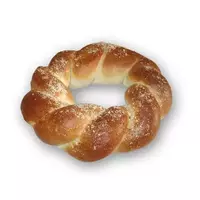Kalatch

Kalach got its original name thanks to the word kolač, which, when literally translated from the ancient Common Slavic language, means "circle. " The meaning of the name of the kalach determines the distinctive shape of the bakery product. Initially, the eastern and southern Slavs called any type of bakery products, including a wedding loaf, Kalachi. In ancient times, they attached special importance to the rounded shape that was associated with the sun. Ancient people worshiped the sun.
For this reason, all bakery products that were baked in the form of a circle were not used for the daily diet. These were, so-called, ritual kalachi or bread. Over time, more and more forms of bread from various varieties and types of flour began to appear. The word kalach has lost its original meaning, and the bakery product has lost its meaning. Currently, a separate type of bun is called kalachi, which have a distinctive circle shape.
Types of kalachi
Over the centuries-old history of the existence of bakery products, a sufficient number of types of kalachi have accumulated. Some types of kalachi no longer enjoy the same popularity among modern consumers. However, once all the inhabitants of Slavic lands did not imagine their lives without a kalach. The following types of kalachi are distinguished:
soft kalachi;
"grated" kalachi;
kalachi-wickers;
kalachi with filling;
kalachi Moscow, Murom, Ural, Saratov, etc. In the old days in Russia, each patrimony could boast of its own original kind of kalachi.
Kalachi is baked from wheat flour of the highest grade. Therefore, the kalachi were often called simply "white bread, " that is, a product made of wheat flour. Over time, the name white bread was assigned to bakery products, which differ in the white color of the crumb. Kalachi was eaten only for particularly important cases. Therefore, the bakery product acted as an independent treat. In addition, kalachi were served to the table as the basis for festive caviar sandwiches or sweet dessert with jam.
It was believed that the best kalachi are produced in Moscow. The fame of the amazing taste of Moscow kalachi spread far beyond the borders of the capital's territories. The unprecedented popularity and popular love for Moscow Kalachs is evidenced by the fact that the Kalachny Ryad, specially established in the 18th century, existed in Moscow. This is a trading place where all residents and guests of the capital could buy a variety in types, fillings and form of kalachi.
Even more surprisingly, during the Russo-French War of 1812, Russian troops were followed by convoys with provisions and mandatory punches, which, after cooking, were frozen in a special way, and then thawed with hot towels. So the bakery product could maintain its consumer properties for more time.
kalacha 249 kKal
Energy value of kalach (Ratio of proteins, fats, carbohydrates - ju):
Proteins: 7.9 g (~ 32 kCal)
Fats: 0.8 g (~ 7 kCal)
Carbohydrates: 51.1 g (~ 204 kCal)
Energy ratio (bj | y): 13% | 3% | 82%
 Español
Español Français
Français Português
Português Русский
Русский 简体中文
简体中文 繁體中文
繁體中文 日本語
日本語 한국어
한국어 العربية
العربية Türkçe
Türkçe Қазақ
Қазақ Deutsch
Deutsch Italiano
Italiano Українська
Українська
